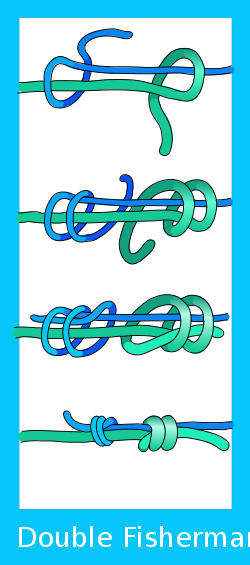Difference between revisions of "AY Honors/Knot/Double Fishermans Knot/es"
From Pathfinder Wiki
< AY HonorsAY Honors/Knot/Double Fishermans Knot/es
(Created page with "Category:Adventist Youth Honors Answer Book/es <noinclude>") |
(Created page with "Knot/es | name = Doble Nudo de Pescador | image = Double_Fisherman%27s_knot.svg | use = Se usa para unir a las líneas finas, rígidas o resbaladizas, respaldando a los nudos...") |
||
| Line 3: | Line 3: | ||
{{ | {{ | ||
| − | Knot | + | Knot/es |
| − | | name = | + | | name = Doble Nudo de Pescador |
| image = Double_Fisherman%27s_knot.svg | | image = Double_Fisherman%27s_knot.svg | ||
| − | | use = | + | | use = Se usa para unir a las líneas finas, rígidas o resbaladizas, respaldando a los nudos críticos. |
Use the double fisherman's knot to tie together two ropes of unequal sizes. This knot and the triple fisherman's knot are the variations used most often in rock climbing, but other uses include search and rescue. | Use the double fisherman's knot to tie together two ropes of unequal sizes. This knot and the triple fisherman's knot are the variations used most often in rock climbing, but other uses include search and rescue. | ||
Revision as of 18:42, 26 June 2016
| Doble Nudo de Pescador |
|---|
|
Uso: Se usa para unir a las líneas finas, rígidas o resbaladizas, respaldando a los nudos críticos.
Use the double fisherman's knot to tie together two ropes of unequal sizes. This knot and the triple fisherman's knot are the variations used most often in rock climbing, but other uses include search and rescue. The primary use of this knot in rock climbing is to form high strength loops of cord for connecting pieces of the rock climber's protection system. It is favoured for being compact, and for arranging the line of force in a straight line through the knot. Another common use for this knot is to back up a critical knot, such as a harness tie-in knot or single-line rappel rigs. In this use, the running end is tied around the standing end of the rope, so that it cannot slip back through the knot.Cómo amarrar:
|

